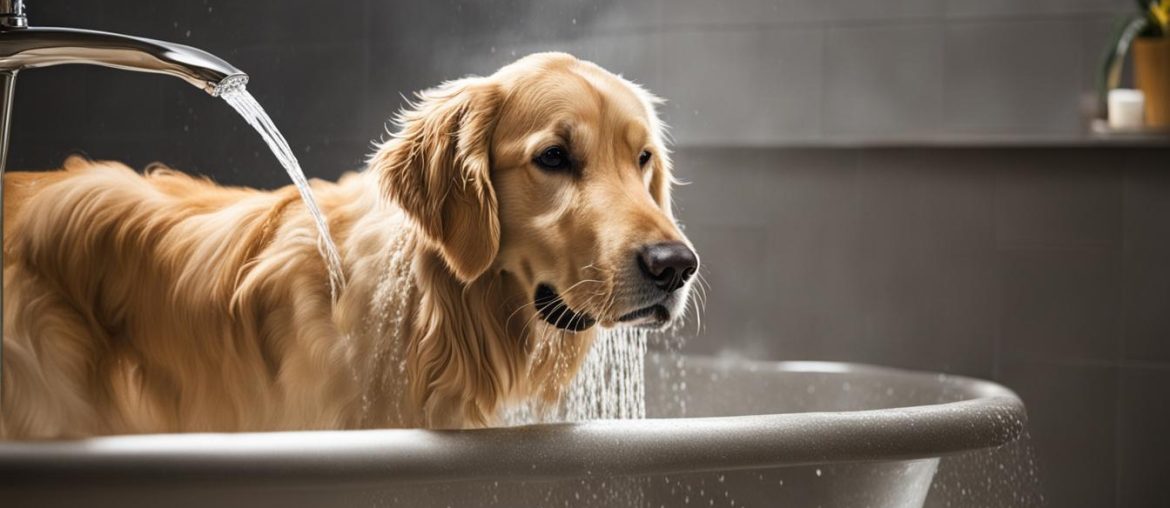Bathing your dog is an essential part of their grooming routine. It not only helps them stay clean and fresh but also contributes to their overall health and hygiene. If you’re wondering how to give a dog a bath, follow these quick and easy steps to ensure a stress-free experience for both you and your furry friend.
Key Takeaways:
- Regular bathing is crucial for your dog’s cleanliness and well-being
- Choose dog-specific shampoo and conditioner for a gentle and effective wash
- Consider your dog’s individual bathing frequency based on their health, coat type, and lifestyle
- Prepare all necessary supplies and create a calm and secure bathing environment
- Use positive reinforcement and reward your dog for a positive bathing experience
Why Should You Wash Your Dog?
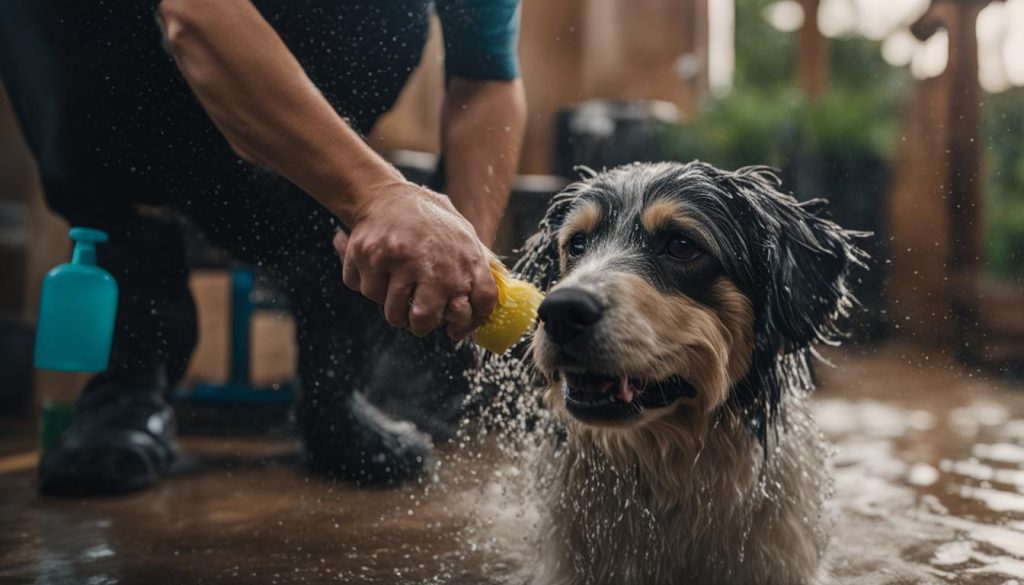
Bathing your dog is not only a necessary part of their grooming routine but also contributes to their overall health and hygiene. Regular bathing helps to remove dirt, debris, and unpleasant odors from your dog’s coat, leaving them clean and fresh. It also plays a crucial role in maintaining their skin health and addressing specific skin conditions.
Proper dog washing techniques involve using a suitable dog shampoo that is specifically formulated for their sensitive skin. Avoid using human shampoos as they can be too harsh and may cause skin irritation. Additionally, consider using a conditioner to keep your dog’s coat soft and tangle-free.
“Bathing your dog helps to remove dirt, debris, and odor from their coat.”
By bathing your dog regularly, you can prevent the buildup of dirt, allergens, and parasites on their coat. This can help reduce the risk of skin infections and keep your dog’s skin healthy. It is essential to choose the appropriate bathing frequency based on your dog’s individual needs, coat type, and lifestyle. Consulting with your veterinarian can provide valuable insights and guidance to determine the optimal bathing routine for your furry friend.
| Benefits of Washing Your Dog | Proper Dog Washing Techniques |
|---|---|
|
|
Remember, bathing your dog is not solely about cleanliness. It is an opportunity to bond with your furry companion and provide them with a positive and calming experience. With the right dog washing techniques, you can ensure that your beloved pet stays clean, healthy, and happy.
How Often Should You Give Your Dog a Bath?
Determining how often to bathe your dog can be a bit of a challenge. The frequency of baths depends on various factors such as your dog’s health, coat type, and lifestyle. While some dogs may benefit from a monthly bath, others may only require bathing a few times a year. It’s important to find a bathing schedule that works best for your dog’s individual needs. Consulting with your veterinarian can provide valuable insights and help you determine the optimal bathing frequency.
H3: Factors to Consider
When deciding how often to bathe your dog, consider the following factors:
- Health: Dogs with certain skin conditions or allergies may require more frequent baths to help alleviate symptoms and maintain a clean coat.
- Coat Type: Dogs with long or dense coats may need more regular bathing to prevent matting, while dogs with short or thin coats may require less frequent baths.
- Lifestyle: Dogs that spend a lot of time outdoors or engage in activities that make them dirty may need more frequent baths to keep them clean and fresh.
H3: Signs Your Dog Needs a Bath
While there is no one-size-fits-all answer to how often you should bathe your dog, there are some signs that indicate they may be due for a bath:
- Unpleasant odor
- Dirt or debris visibly stuck to their coat
- Matted or tangled fur
- Excessive scratching or itching
By paying attention to these signs and taking into account your dog’s specific needs, you can develop a bathing routine that keeps them clean, healthy, and comfortable.
| Coat Type | Bathing Frequency |
|---|---|
| Short or thin coat | Every 3-6 months or as needed |
| Medium coat | Every 2-4 months or as needed |
| Long or dense coat | Every 1-2 months or as needed |
Remember, it’s important to use dog-specific shampoos and conditioners when bathing your furry friend. This helps to ensure their skin and coat stay healthy and free of irritation. Additionally, always use lukewarm water and avoid getting soap in their eyes or ears. With proper care and attention, you can find the best bathing routine for your dog and keep them looking and feeling their best.
What Do I Use to Give a Dog a Bath?
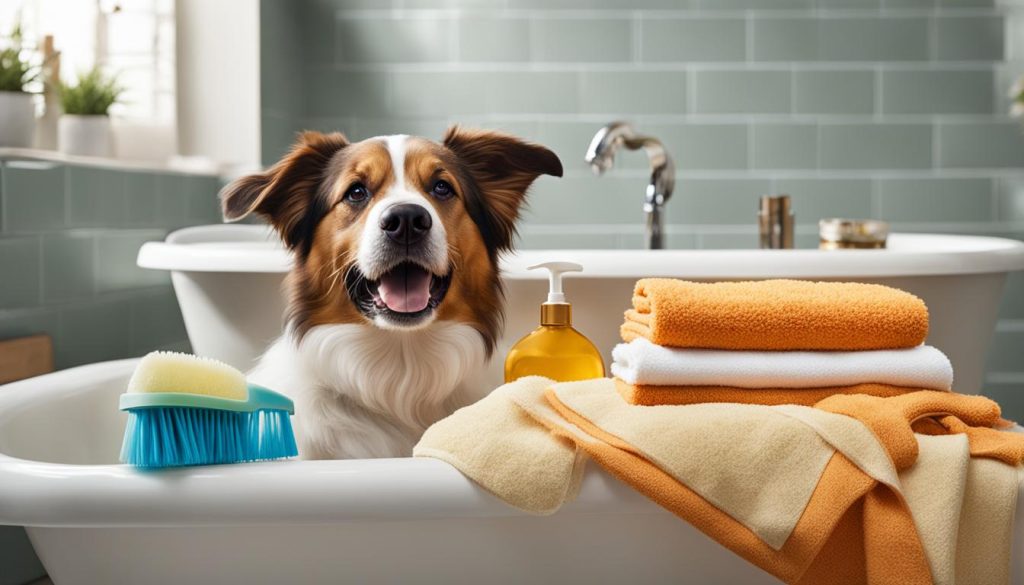
When it comes to giving your dog a bath, using the right products is crucial. Choose a shampoo that is specifically formulated for dogs, as human shampoos can be harsh on their sensitive skin. Look for a shampoo that is gentle, hypoallergenic, and free from any harmful chemicals. A moisturizing shampoo with natural ingredients can help keep your dog’s coat soft and healthy.
In addition to shampoo, consider using a conditioner to keep your dog’s coat tangle-free and manageable. Conditioners can help moisturize their skin and provide extra hydration for dogs with dry or itchy skin. Choose a conditioner that is suitable for your dog’s coat type, whether it’s short, long, curly, or wiry.
When bathing your dog, it’s important to have the right tools and accessories on hand. Make sure you have plenty of towels to dry your dog after their bath. Absorbent microfiber towels are great for removing excess water from their fur quickly. You may also need a brush or comb to remove any tangles or mats in their coat. Use a brush that is suitable for your dog’s coat type to avoid any discomfort or damage to their fur.
Table: Dog Bath Essentials
| Essential | Description |
|---|---|
| Shampoo | Avoid using human shampoo as it can be too harsh for dogs. Look for a dog-specific shampoo that is gentle and hypoallergenic. |
| Conditioner | Conditioners can help keep your dog’s coat soft, tangle-free, and moisturized. Choose a conditioner suitable for their coat type. |
| Towels | Have plenty of towels on hand to dry your dog after their bath. Microfiber towels are absorbent and great for removing excess water. |
| Brush or comb | Use a brush or comb suitable for your dog’s coat type to remove tangles or mats. Regular brushing keeps their coat healthy and reduces shedding. |
| Grooming wipes | Grooming wipes are handy for cleaning and refreshing your dog’s coat between baths. Choose wipes that are safe for dogs and free from harsh chemicals. |
Having these essentials on hand will ensure a smooth and successful bathing experience for both you and your furry friend. Remember to always use products that are safe and specifically designed for dogs to keep their skin and coat healthy.
Where Should I Give My Dog a Bath?
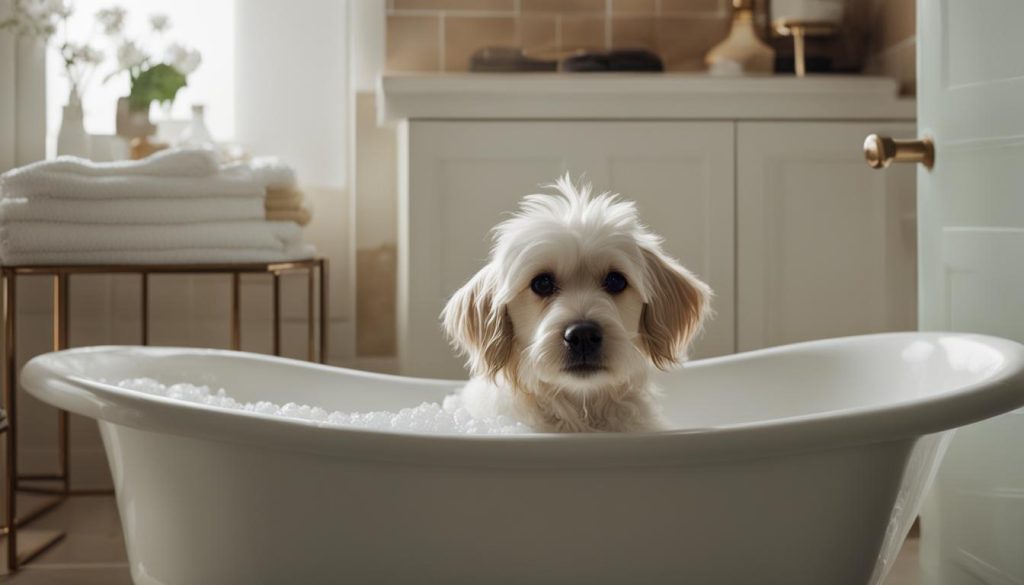
When it comes to bathing your dog at home, choosing the right location is essential for both you and your furry friend. The ideal bathing area should be safe, comfortable, and easily accessible. Consider the size of your dog and the available space in your home or yard.
For smaller dogs, a sink can be a convenient option. It allows you to control the water flow and minimize mess. Use a nonslip mat in the sink to prevent your dog from slipping and getting injured during the bath. Make sure the water temperature is comfortable and avoid any sudden temperature changes that may startle your dog.
If you have a larger dog, a bathtub or an outdoor area may be more suitable. A bathtub provides ample space for your dog to move around, making it easier for you to reach all areas of their body. Ensure that the bathtub is clean, nonslip, and free of any objects that could cause harm.
For those who prefer bathing their dogs outdoors, consider using a portable dog bathing station or setting up a designated bathing area in your yard. This can be especially beneficial for dogs who become anxious or stressed when bathed indoors. Just make sure the area is securely fenced and provides enough privacy for your dog’s comfort.
| Location | Advantages | Disadvantages |
|---|---|---|
| Sink | – Convenient and easily accessible – Control over water flow |
– Limited space for larger dogs – Potential for making a mess |
| Bathtub | – Ample space to move around – Easier reach for all areas |
– May require lifting larger dogs – Bathing area should be nonslip |
| Outdoor area | – Less anxiety for some dogs – More space for larger dogs |
– Weather limitations – Requires a secure and private area |
Remember, regardless of the location you choose, creating a calm and soothing environment during bath time will help make the experience more enjoyable for both you and your dog. Always stay attentive to their reactions and ensure their safety throughout the bathing process.
How Should I Wash My Dog?
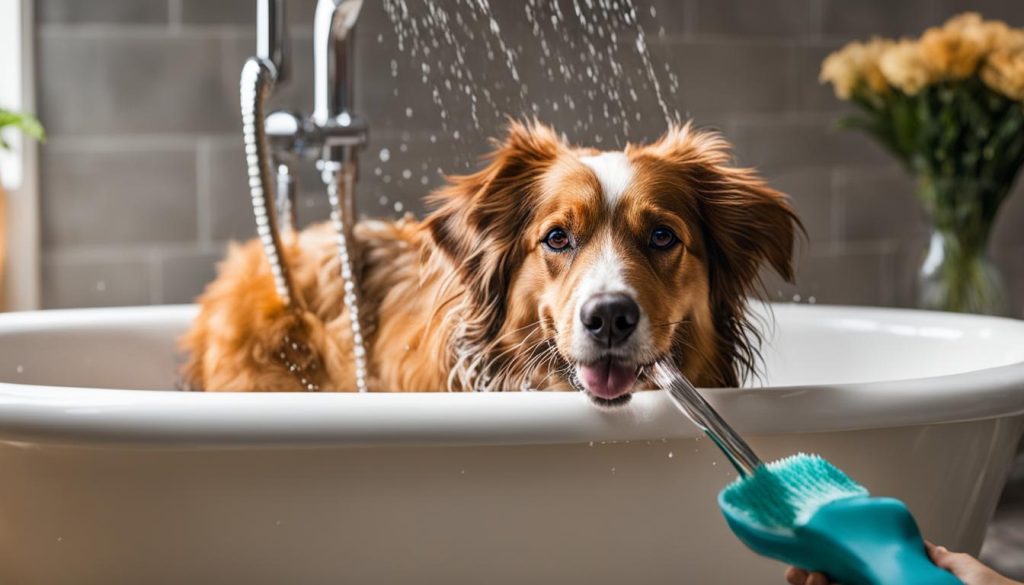
Washing your dog is a step-by-step process that ensures a thorough and effective bath. Follow these steps to ensure your dog receives a proper and comfortable bathing experience:
Gather Your Supplies
Before you begin bathing your dog, make sure you have all the necessary supplies within reach. This includes dog-specific shampoo, towels, a brush, and grooming tools. Having everything prepared beforehand will help streamline the bathing process and minimize any unnecessary stress for your furry friend.
Wetting and Shampooing
Start by wetting your dog’s coat thoroughly with lukewarm water. Ensure that their entire body is wet, including hard-to-reach areas such as the belly and paws. Once their coat is wet, apply a small amount of dog shampoo and lather it gently into their fur. Take care to avoid getting shampoo in their eyes and ears.
Rinsing and Drying
After shampooing, thoroughly rinse your dog’s coat with clean water. Make sure to remove all traces of shampoo to prevent any skin irritation. Once rinsed, use towels to absorb excess water from your dog’s coat. If necessary, you can use a blow dryer on a cool setting, keeping it at a safe distance from your dog’s skin. However, it’s important to prioritize your dog’s comfort and not subject them to anything that causes stress or discomfort.
| Step | Description |
|---|---|
| Step 1 | Gather your supplies: dog shampoo, towels, brush, grooming tools. |
| Step 2 | Wet your dog’s coat thoroughly with lukewarm water. |
| Step 3 | Apply a small amount of dog shampoo and lather it gently into their fur. |
| Step 4 | Rinse your dog’s coat thoroughly with clean water. |
| Step 5 | Use towels to absorb excess water from your dog’s coat. |
| Step 6 | Consider using a blow dryer on a cool setting if necessary, keeping it at a safe distance from your dog’s skin. |
By following these steps, you can ensure a successful and comfortable bathing experience for your dog. Remember, patience and positive reinforcement can go a long way in making bath time an enjoyable routine for both you and your furry companion.
Why Do Dogs Hate Baths?
When it comes to bathing your furry friend, you may have noticed that not all dogs are thrilled about the idea. Many dogs exhibit resistance or fear when it comes to bath time. But why do some dogs hate baths? Understanding the reasons behind this aversion can help you create a positive and calm bathing experience for your canine companion.
One possible reason for a dog’s dislike of baths is previous negative experiences. If a dog has had a traumatic or uncomfortable bathing experience in the past, they may develop fear or anxiety around water. This can make bath time a source of stress for both the dog and the owner.
Additionally, some dogs simply have a general dislike of water. Certain breeds, such as cats and some toy breeds, are known to be less fond of water than others. It’s important to remember that each dog is unique and may have individual preferences and sensitivities.
To help alleviate your dog’s anxiety and make bath time more enjoyable, there are a few strategies you can implement. First, provide positive reinforcement during the bathing process. Use treats, praise, and soothing words to let your dog know that bath time can be a rewarding experience. Creating a calm and gentle environment can help ease their fears.
Overall, understanding why some dogs hate baths can help you approach the bathing process with empathy and patience. By providing positive reinforcement, creating a calm environment, and addressing any previous negative experiences, you can help your dog overcome their fear and make bath time a more pleasant experience for everyone involved.
Before Your Dog Gets Wet
Preparing for your dog’s bath is essential to ensure a smooth and stress-free grooming experience. By gathering all the necessary supplies and taking certain precautions, you can create a comfortable environment for your furry friend. Here are some dog bath essentials to consider:
- Appropriate shampoo: Choose a shampoo specifically formulated for dogs, as human shampoos can be harsh on their skin. Look for gentle and hypoallergenic options that suit your dog’s needs.
- Towels: Have several towels on hand to dry your dog after the bath. Opt for absorbent towels that are large enough to wrap around your dog.
- Grooming tools: Depending on your dog’s coat type, you may need a brush or comb to remove any tangles or loose hair before the bath. This helps prevent matting and ensures a more effective cleaning.
- Nonslip surface: Use a nonslip mat or towel in the bathing area to provide stability for your dog and prevent any accidents. This is particularly important if you’re bathing your dog in a bathtub or sink.
| Supply | Recommendation |
|---|---|
| Shampoo | Choose a gentle and hypoallergenic shampoo formulated for dogs. |
| Towels | Have several absorbent towels for drying your dog after the bath. |
| Grooming tools | Use a brush or comb to remove tangles and loose hair before the bath. |
| Nonslip surface | Ensure stability in the bathing area with a nonslip mat or towel. |
By having these essentials ready before your dog gets wet, you’ll be well-prepared for a successful and enjoyable bathing session. Remember to be patient and provide positive reinforcement throughout the process to keep your dog calm and comfortable.
Time to Splish and Splash

Now that you’ve prepared all the necessary supplies and created a calm bathing environment, it’s time to give your dog a refreshing bath. Follow these step-by-step instructions to ensure a successful bathing experience.
Gentle Introduction
Begin by introducing your dog to the bathing area in a calm and reassuring manner. Use positive reinforcement, such as treats or praise, to create a positive association with bath time. Allow your dog to sniff and explore the area before proceeding with the bathing process.
Wet and Shampoo
Wet your dog’s fur thoroughly with lukewarm water, making sure to avoid the face and ears. Gently massage the appropriate amount of dog shampoo into your dog’s coat, working up a lather. Pay special attention to areas that are prone to odors or dirt buildup, such as the paws and underbelly.
Take care to avoid getting shampoo in your dog’s eyes or ears, as it can cause irritation. Use a tearless shampoo for extra safety. Massage the shampoo into your dog’s coat, working from head to tail, and leave it on for the recommended amount of time as indicated on the shampoo bottle.
Rinse and Dry
Thoroughly rinse off all the shampoo from your dog’s coat, ensuring there are no traces of soap left behind. Use lukewarm water and gently pour it over your dog’s body, making sure to rinse every area, including the underbelly, legs, and tail. Take extra care to rinse all the way to the skin, as residual shampoo can cause itchiness and skin irritation.
After rinsing, use towels to gently pat your dog dry, absorbing excess water. If your dog tolerates it, you can use a blow dryer on a cool setting to speed up the drying process. However, be cautious and keep the dryer at a safe distance to prevent overheating or stressing your dog. Remember to hold their muzzle gently to prevent them from shaking and getting water everywhere.
Keep your dog indoors until they are completely dry to prevent them from rolling in dirt or getting wet again. This will ensure that your dog stays clean and fresh for as long as possible. Congratulations, you’ve successfully given your dog a bath!
Dry the Dog Instead of Soaking Yourself
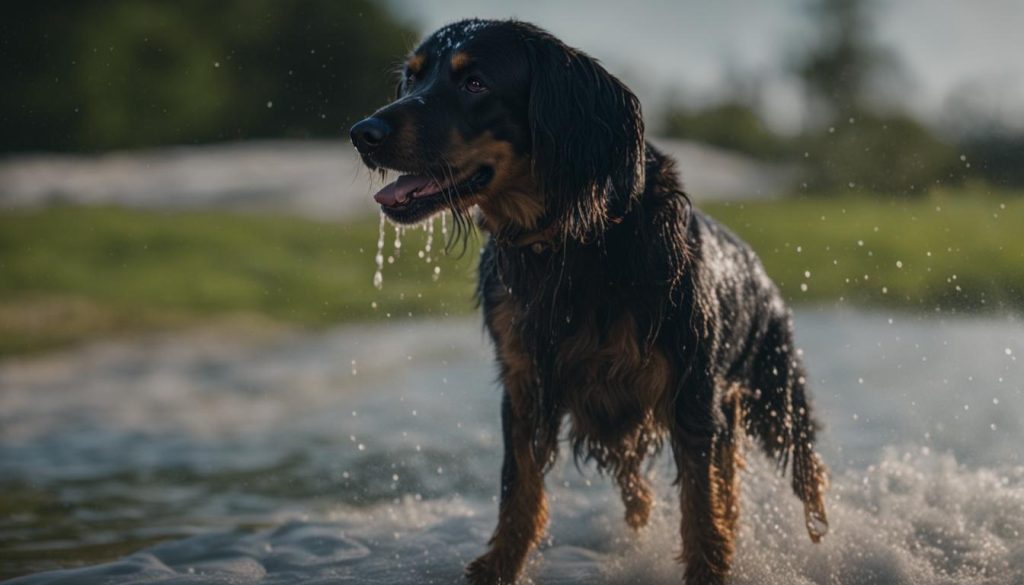
After giving your dog a bath, it’s important to thoroughly dry their coat to prevent them from getting cold or uncomfortable. Here are some tips on how to effectively dry your dog:
- Start by using a towel to gently pat and rub your dog’s coat. This will help absorb excess water and prevent dripping.
- If necessary, you can use a blow dryer on a cool setting to further dry your dog’s coat. Keep the dryer at a safe distance from your dog’s skin to prevent any discomfort.
- While drying, be mindful of your dog’s comfort and stress levels. Use gentle strokes and ensure that the blow dryer is not causing any anxiety or fear.
- If your dog tends to shake off water after a bath, gently hold their muzzle to prevent them from shaking and getting water everywhere.
By following these steps, you can ensure that your dog’s coat is dry and they are comfortable after their bath. Remember to provide a calm and positive environment throughout the drying process to make it a pleasant experience for your furry friend.
Keeping your dog dry after a bath is an important part of their grooming routine. By properly drying their coat, you can prevent discomfort, protect their health, and maintain their overall well-being.
Wrapping Up
Giving your dog a bath can be made easier and more enjoyable by following these step-by-step instructions and using the right products. Regular bathing is an important part of your dog’s grooming routine and contributes to their overall health and hygiene. Always ensure you provide a positive and calm bathing experience for your furry friend.
FAQ
How often should I give my dog a bath?
The frequency of bathing your dog depends on various factors such as their health, coat type, and lifestyle. Some dogs may need a monthly bath, while others may only require bathing a few times a year. It’s best to consult with your veterinarian to determine the optimal bathing frequency for your dog.
What products should I use to give my dog a bath?
It’s important to use appropriate products when bathing your dog. Choose a shampoo that is specifically formulated for dogs, as human shampoos can be harsh on their skin. Additionally, consider using a conditioner to keep their coat soft and tangle-free. Ensure you have a variety of towels, a brush, and other grooming tools on hand.
Where should I give my dog a bath?
The location for bathing your dog depends on their size and your available space. Smaller dogs can be bathed in a sink, while larger dogs may require a bathtub or outdoor area. Consider using nonslip surfaces and ensuring the area is calm and secure to make the bathing process more comfortable for your dog.
How should I wash my dog?
Begin the bathing process by wetting your dog’s coat, then apply the appropriate amount of shampoo and work it into a lather. Pay special attention to sensitive areas such as the face and underside. Rinse your dog thoroughly to remove all soap residue. Towel dry your dog, avoiding the use of blow dryers unless specifically designed for pets.
Why do some dogs hate baths?
Not all dogs enjoy bath time, and some may exhibit resistance or fear. This can be due to previous negative experiences or a general dislike of water. Providing positive reinforcement, using treats, and making the bathing process calm and gentle can help alleviate their anxiety.
What should I do before giving my dog a bath?
Before bathing your dog, gather all necessary supplies such as the appropriate shampoo, towels, and grooming tools. Brush your dog’s coat to remove any tangles or loose hair. Use a nonslip surface in the bathing area to prevent accidents.
How should I dry my dog after bathing?
After bathing your dog, use towels to dry their coat and absorb excess water. If necessary, use a blow dryer on a cool setting, taking care not to burn or stress your dog. Prevent your dog from shaking water by gently holding their muzzle.


